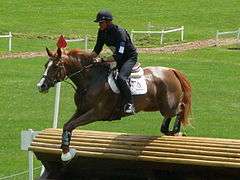Anglo-Arabian
The Anglo-Arabian or Anglo-Arab is a crossbred, part-Arabian horse that now also has its own status as a horse breed. It is the result of a Thoroughbred (hence, the prefix "Anglo") being crossed with an Arabian. The cross can be made between a Thoroughbred stallion and an Arabian mare, or vice versa. It can also be a cross between either an Anglo-Arab and a Thoroughbred or, alternatively, an Anglo-Arab and an Arabian. Another permitted cross is between two Anglo-Arabians. No matter the cross, a horse must have a minimum 12.5% of Arabian blood to be considered an Anglo-Arabian.
A gray Anglo-Arabian | |
| Other names | Anglo-Arab |
|---|---|
| Country of origin | Worldwide, most popular in the United Kingdom, France, and the United States |
| Traits | |
| Distinguishing features | Well-formed, powerful, good gaits, sport horse characteristics. Combines traits of both Arabian and Thoroughbred breeds |
| Breed standards | |
France is one of the greatest producers of Anglo-Arabians. The French Anglo-Arab traces back to two stallions: the Arabian stud Massoud and Aslam, a "Turkish" horse, probably of the now-extinct Turkoman or "Turkmene" breed. These Syrian imports were then crossed with a trio of Thoroughbreds, specifically, the Comus Mare, the Selim Mare, and Daer. Some years later, three of their daughters — Clovis, Danae, and Delphine — formed the foundation of the French Anglo-Arabian breeding program. The program's primary Anglo-Arab breeding farm, Pompadour National Anglo-Arab Stud, is located in Arnac-Pompadour, a commune of central France's Corrèze department, home to the famous Château de Pompadour. In addition, the area serves as the French National Stud's headquarters. The Anglo-Arabian possesses one of France's oldest studbooks, and the Selle Français, the country's leading sport horse, still bears the stamp of significant Anglo-Arab influence.
In the past, the Anglo-Arab has been used for military purposes. However, at present, its most prominent occupation is that of a general riding or sport horse. The breed does well in eventing, due to its stamina, speed, and jumping ability. In the United States, the Anglo-Arabian is considered a "part-bred" Arabian and, as a result, is registered within a separate section of the Arabian Horse Association.
Breed Characteristics


As a result of different crosses that can produce an Anglo-Arabian, the size and appearance is noticeably variable. However, on average, an Anglo-Arabian is a bit taller than the average Arabian and of somewhat less refined type. The largest horses are usually produced by breeding a Thoroughbred mare to an Arabian stallion. The best examples of this breed inherit the refinement, good bone, and endurance of the Arabian, as well as the speed and scope of the Thoroughbred.
Anglo-Arabians average 15.2–16.3 hands (62–67 inches, 157–170 cm) high. The most common colors are chestnut, bay (sometimes called "brown") or gray. The breed ideal is for a horse to have conformation that more strongly resembles the Arabian, though they should not look entirely like either a Thoroughbred or an Arabian. They have a long neck, prominent withers, a compact and strong body (sturdier than the Thoroughbred), a deep chest, and solid bone. Anglo-Arabians should have small, fine heads, similar to an Arabian, but they should not be overly "dished" in profile.
References
| Wikimedia Commons has media related to: |